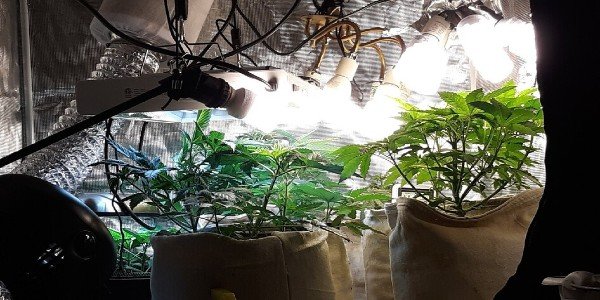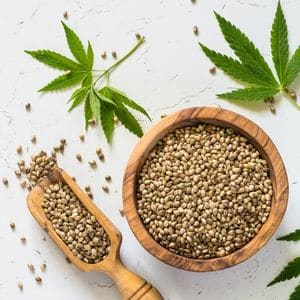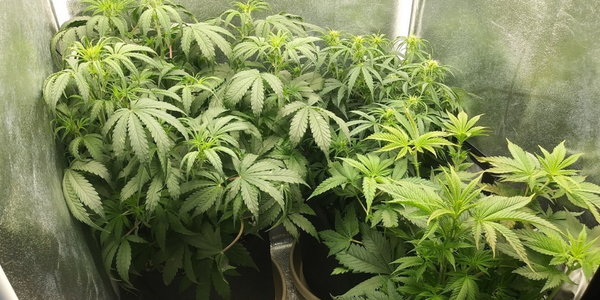Compact fluorescent lighting (CFL) bulbs are one type of lighting method to use when growing cannabis plants.
CFL bulbs are cheap, like incandescent lights, but don’t produce any of the heat that incandescent bulbs do, making them the ideal light fixture for an indoor garden that doesn’t have a lot of space.
Download my free marijuana grow guide and start growing your own high quality marijuana strain.
Grow Bible

- Grow with my Quick Start Guide
- Discover secrets to Big Yields
- Avoid common grow mistakes
Error: Contact form not found.
So, how many CFLs for one plant do you need?
‘How many CFLs per plant?’ is a question that growers often ask, especially those working with compact setups.
Surprisingly, there are different answers to this question depending on who you turn to.
Some growers might say that six CFLs are the best, while others argue that four are more than enough.
There are different answers because CFLs come in various wattages (W), sizes, and color temperatures.
To know how many CFLs you need for your setup, you need to understand these three factors (wattages, sizes, and color temperatures) because they can influence the overall yield of your marijuana plants.
- Wattage: You need to get around 150W per plant to yield 1oz of bud. The more watts your CFLs have, the brighter the light they will emit. Bright light is essential for effective light penetration that your plants need to grow.
- Size: Generally, larger CFLs have higher watts and generate more heat since they’re too close to the plants.
- Color Temperature: Color temperature is measured in kelvins (K). Don’t be alarmed since that measures color and not the actual temperature that the bulbs generate.
So back to the initial question, how many CFLs per plant?
- 6 if using small CFLs
- 4 if medium-sized CFLs
- 3 if large CFLs
How Many CFLs Per Plant
| Amount | Size | Wattage | Color Temperature |
| 3x | Small | 23W | 6500K |
| 3x | 26W | 2700K | |
| 2x | Medium | 42W | 6500K |
| 2x | 40W | 2700K | |
| 1x | Large | 65W | 6500K |
| 2x | 65W | 2700K |

The benefits of growing with CFLs
When it comes to indoor growing, CFL bulbs offer plenty of benefits for your cannabis plants.
They’re a better alternative to incandescent bulbs since they don’t produce as much heat.
Another advantage to using CFLs over incandescent bulbs is that they’re much more energy-efficient than incandescent ones, which helps with lowering the overall cost of maintaining your indoor setup.
They can also help with the overall vegetative growth of your plants since CFLs offer effective light penetration.
In other words, every part of your cannabis will get adequate amounts of light.

Buy Indoor Marijuana Seeds
- Easy to grow
- Guaranteed germination
- Beginner friendly
- Grow guide available
Speaking of light, CFLs offer a range of color temperatures that goes from warm to cool light.
The color of light matters to your plants because cannabis grows more effectively under certain light colors.
In the case of their vegetative stage, plants will do better under cool or daylight colored CFLs (6500K).
Meanwhile, during flowering, they would prefer warm-colored CFLs (2700K).
Lastly, CFL bulbs are a lot easier to place than other light fixtures because they can come in a range of sizes and don’t generate nearly as much heat, which allows you to place them as close as possible to your plants.
Easy placement makes them ideal grow lights for small setups that don’t offer much space.
Do CFLs help plants grow?
CFL bulbs help your plants grow by providing the light they need for photosynthesis like most grow lights.
They’re better than other grow lights by being energy efficient and providing adequate light for your cannabis.
Are CFLs good for flowering?
It depends on the color temperature of your CFL bulbs.
Typically you would want CFLs with a color temperature of 2700K because they will emit an effective amount of warm, orange light on flowering cannabis.
Is 2700K good for growing?
You can use CFLs with a color temperature of 2700K throughout the entire growing process, but use them especially when flowering cannabis.
Is CFL better than LED?
Generally, LED lights are better than CFLs in increasing the yield of your cannabis.
LEDs are far more efficient than CFLs, and they last three times longer.
However, the downside to LEDs is that you need to keep a minimum distance of 12-18 inches from your plants, making them unsuitable for compact setups.

How high should my CFL be from my plant?
Where you place your CFLs depends on how you choose to grow your cannabis plants.
Typically, you need to ensure that every part of your plants gets adequate light.
The rule of thumb here is you need to put CFL bulbs on any dark spots around your indoor setup; this means having to put CFLs on the sides or even at the base of your plants.
However, if you’re growing topped cannabis, you won’t need to hang any of the CFL bulbs anywhere except over your plants.
Remember that you still need to avoid placing the bulbs too close to your plants, as doing so can put your plants at risk of being burned.
Placement of your CFLs can also depend on the bulb size and its wattage.
Typically smaller bulbs with low wattage can hang much closer to your cannabis than larger bulbs.

How do you grow autoflowers with CFL?
Growing autoflowers with CFLs isn’t that different from using any other type of grow lights.
Growing with CFLs is similar to using metal halide, and high-pressure sodium HID lights on large-scale indoor setups.
During the vegetative stage of your plants, you need to use CFLs that have a 6500K color temperature, which is the equivalent of using metal halide HID lights that produce a cool white light.
While your autoflowers are vegging, you must ensure that the canopies remain short, which is not tricky considering most autoflowers are compact plants.
Once your autoflowers enter their flowering stage, you need to switch the CFL type from 6500k to 2700k.
The 2700k is the CFL version of the high-pressure sodium HID lights, producing a warm orange glow.

How many CFLs for a single plant?
The number of CFLs you need for a single plant depends entirely on their wattage.
To get the best yield possible, you would need 150W worth of CFLs for one cannabis plant, either 6 small 23-26W CFL bulbs, 4 medium 40-42W bulbs, or 3 large 65W bulbs.
If you plan to have exclusive lights for vegging and flowering, you would need to purchase double the amount of bulbs.
Remember, vegging CFL grow lights need a color temperature of 6500K. Flowering CFL grow lights need a 2700K color temperature.
If you’re having trouble finding the sweet spot for your setup, you can always try to mix and match different bulb wattages to provide an adequate amount of light.
Conclusion
CFLs might not be as energy-efficient or long-lasting as LEDs, but they have their advantages.
They’re the only type of grow light for cramped or compact setups that don’t have enough space for LEDs and HIDs lights.
Hopefully, this article answered those ‘how many CFLs per plant’ and other related questions.
If you want to know more about growing, you can download my Grow Bible so you can start growing like a pro.
Happy Growing,
Robert Bergman
FAQs about CFLs
CFL bulbs are a great source of artificial indoor lighting that you can use for your seedlings. One 6500K CFL bulb is enough for two seedlings.
Yes, CFL bulbs are a type of fluorescent lighting. They operate the same way as regular fluorescent lights – agitate a gas inside the tube to produce light. This method of producing light makes CFL bulbs generate low amounts of heat.
The post How many CFLs per plant? appeared first on I Love Growing Marijuana.
